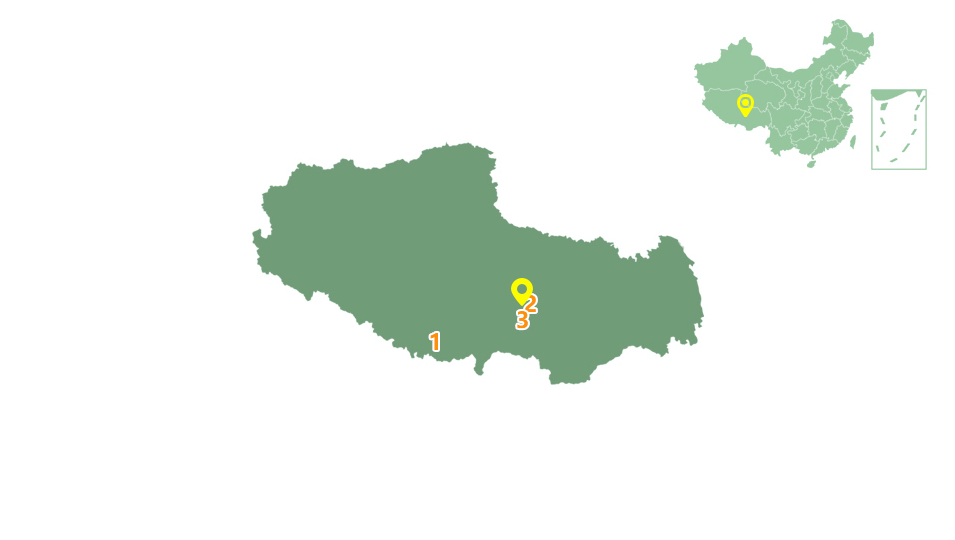
Dadong Village in Lhasa, Tibet, China
Dadong Village in Liuwu New District, Lhasa has eight villager groups, and a total of 218 farmer and herdsman households with 796 people, including 51 registered impoverished households with 183 people who were targeted poverty alleviation work. The village’s poverty headcount ratio was 22.99%. Since the initiation of village tourism operations in July 2016, Dadong Village has adopted a "government + company + agricultural households" poverty alleviation model and took an integrated approach with government playing the leading role, operation by enterprises running the operations, shareholding by cooperatives, and income increase for farmers and herdsmen. A variety of tourism projects and brands have been developed that specialized in plateau eco-tourism and ethnic minority cultural experience, with the focus on promoting “1,000 mu of flowers and Tibetan-style recuperation”. Thus the village became the first “composite type of tourism village" in Lhasa. In 2017, the annual per capita income of Dadong Village reached 8,048 RMB. In January 2018, the village was officially removed from the list of impoverished villages and realized the goal of combining a thriving industry, beautiful environment, and prosperous villagers.
Photos
-
 Houses before and after renovation
Houses before and after renovation
-
 Night view of a VIP homestay in the mountains
Night view of a VIP homestay in the mountains
-
 Aerial view of Dadong
Aerial view of Dadong
-
 Dividend distributing meeting
Dividend distributing meeting
-
 A thousand mu of flowers
A thousand mu of flowers
-
 Looking into the distance
Looking into the distance
Scenic Spots in Surrounding Areas
-
 Tibet Autonomous Region 1.Qomolangma National Park 2.Jokhang or Dazhao Temple 3.The Potala Palace
Tibet Autonomous Region 1.Qomolangma National Park 2.Jokhang or Dazhao Temple 3.The Potala Palace
-
 Qomolangma National Park is situated in southwest Tibet bordering Nepal where several different geographic regions intersect. The park covers an area including the world's highest peak Mount Qomolangma and the world's highest-altitude temple Rongbuk Monastery, home to plentiful diverse rare and endangered species. It is the highest-altitude national park in the world.
Qomolangma National Park is situated in southwest Tibet bordering Nepal where several different geographic regions intersect. The park covers an area including the world's highest peak Mount Qomolangma and the world's highest-altitude temple Rongbuk Monastery, home to plentiful diverse rare and endangered species. It is the highest-altitude national park in the world.
-
 Jokhang or Dazhao Temple, located in the center of Lhasa’s old city, Tibet, was built for the Tibetan king Songtsen Gampo more than 1,300 years ago. Johkang is a Tibetan word. As the destination of pilgrimage for Tibetan Buddhists, the temple holds the supreme status in Tibetan Buddhism. It was built during the Tubo period, the most glorious period in Tibetan history. It is the oldest building with a clay and wooden structure in Tibet, and the one that initiated Tibetan temple building on flat land.
Jokhang or Dazhao Temple, located in the center of Lhasa’s old city, Tibet, was built for the Tibetan king Songtsen Gampo more than 1,300 years ago. Johkang is a Tibetan word. As the destination of pilgrimage for Tibetan Buddhists, the temple holds the supreme status in Tibetan Buddhism. It was built during the Tubo period, the most glorious period in Tibetan history. It is the oldest building with a clay and wooden structure in Tibet, and the one that initiated Tibetan temple building on flat land.
-
 The Potala Palace, located in northwest Lhasa, Tibet Autonomous Region, is the world’s highest-altitude building combining palaces, castles and temples. It is also the largest ancient building complex in Tibet. “Potala” is a Sanskrit word, originally referring to the residence of Avalokitesvara Bodhisattva. As a sacred place to all Buddhist pilgrims, the Potala Palace has been listed as a World Cultural Heritage Site.
The Potala Palace, located in northwest Lhasa, Tibet Autonomous Region, is the world’s highest-altitude building combining palaces, castles and temples. It is also the largest ancient building complex in Tibet. “Potala” is a Sanskrit word, originally referring to the residence of Avalokitesvara Bodhisattva. As a sacred place to all Buddhist pilgrims, the Potala Palace has been listed as a World Cultural Heritage Site.




